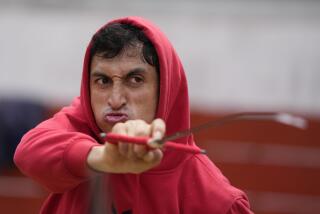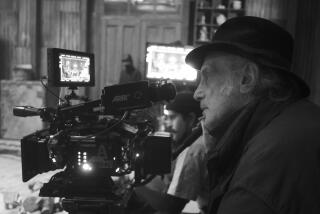Profile : Colombia’s Latest Hero Is the Man Who Kills the Bulls : A matador named Cesar Rincon has helped restore a measure of dignity to a country brutalized by drug violence.
- Share via
BOGOTA, Colombia — The duel flashed across the Atlantic, live from Spain. Before a hushed crowd at La Venta, Madrid’s cathedral of bullfighting, stood Cesar Rincon, the upstart little matador from Colombia, his face twisted in fierce, unblinking concentration before a 1,100-pound enemy with horns.
To millions of television viewers here, the next moments were a collage of electrifying images:
Rincon, his back arched and feet planted, taunting the wounded bull with a red and yellow cape. Rincon leading the charging beast inches from his body with balletic passes and twirling veronicas. Rincon bumped but still afoot, his rose-colored suit stained by the animal’s blood.
And finally, Rincon leaping to plunge a sword deep in the bull’s neck. The doomed animal collapsing. King Juan Carlos of Spain applauding from the royal box amid a sea of white handkerchiefs. The matador clutching his trophies--the bull’s ears--one in each raised fist.
“Colombiano! Colombiano!” chanted patrons at La Red, a Bogota restaurant, clinking wine glasses and tossing carnations at the TV screen.
“Now I can die in peace knowing that one of our matadors has triumphed in Spain,” said Gonzalo Uribe, 63, the bartender at La Giralda social club down the street.
Bullfighting is an art that sickens as many as it thrills.
But in Colombia, a country brutalized by cruder forms of mayhem, this 25-year-old matador has become a national hero. His sudden rise to the world pinnacle of tauromaquia has restored a measure of national pride among violence-battered Colombians, including many who could care less for his profession.
“Colombia needs your triumphs,” President Cesar Gaviria told Rincon in a telephone call right after the Madrid performance. “Little by little, you are changing the image of our country.”
That afternoon, June 6, Rincon did something no bullfighter had ever done: He left the world’s most prestigious ring for the third straight time on the shoulders of spectators. A matador earns a triumphal exit if judges award him both of the bull’s ears for an afternoon’s work--a feat rarer than a complete-game shutout in baseball.
Unheard of outside Colombia, Rincon started his streak May 21 by winning two ears at La Venta’s Festival of San Isidro. Filling in for an injured matador, he astonished the bullfighting world by duplicating that achievement the next day.
The June 6 event was a matchup between Rincon and veteran Jose Ortega Cano, 37, Spain’s top matador this season. Their mano a mano ended in a festive draw; each won two ears from his second bull, one from his third.
Rincon’s triumphs, recorded on live TV and front pages at home, have given Colombians a respite from the curse of car bombings, assassinations and kidnapings that have killed thousands in the drug wars and guerrilla uprisings of recent years.
Some say his feats have eased a national stigma. “Colombian? Oh, yes, (they say,) a narcotics trafficker. Or, ‘Oh yes, a motorcycle assassin,’ ” wrote Semana magazine columnist Antonio Caballero. “Cesar Rincon has worked a miracle. He is congratulated for being Colombian.”
Other commentators have held up the matador’s tenacity and finely honed technique as models for confronting Colombia’s problems. “Rincon has shown that our youth can be brave and intelligent enough to use their brains to dominate the monster and check its killer instincts,” Jorge Salgar wrote on the editorial page of El Espectador.
The bullfighter’s modesty, fragile physique and rags-to-riches life story add to his appeal. Julio Cesar Rincon grew up in Fatima, a barrio of Bogota, and sold souvenirs at bullrings on weekends. He bought his first bicycle with his savings. It was stolen eight days later.
His father, a photographer and amateur matador who dreamed of professional glory for his son, bought Cesar a cape at age 11, let him quit school at 14 and fed him hormones to make him taller.
The kid needed every advantage. He stopped growing at 5-feet-5 3/4, which means that even today, at the top of the sport, he must look up at most of his adversaries’ horns.
Gored several times in his early career, he ignored doctors’ advice to quit. His growing success earned the attention of some Colombian bull breeders, who paid for his first trip to Spain in 1982, when he was 16.
Tragedy stuck on the eve of his debut there. His mother and 20-year-old sister, devout Roman Catholics, lit a shrine in the family’s Bogota home and went to sleep praying for his life. The candles tipped over, igniting chemicals in the father’s photo lab. The wooden house was destroyed. Both women died.
The family tragedy only doubled the teen-ager’s determination. The next year, he was named Colombia’s most promising young matador. But that promise was undermined by a poor season in Spain in 1986. Like a major leaguer sent down to the minors, he spent the next three seasons fighting 120 bulls in every ring in Colombia--some as far as four hours by road from the nearest hospital.
“I always got up and started over,” the matador said in a telephone interview from his apartment outside Madrid. “I grew up poor. I never lost the desire to triumph and become somebody.”
Bullfighting is more popular and highly developed in Colombia than in any other Latin American country except Mexico. Thanks in part to drug traffickers’ investments in bulls, the sport has enjoyed a modest boom in recent years, with towns as small as 5,000 inhabitants building full-sized rings. Matador schools in Bogota and Cali have dozens of students; a fan can choose among 50 or so first-rate bullfights during the 10-week winter season, paying as much as $40 for a good seat.
But no Latin American matador can become rich or famous without succeeding in Spain, which invented bullfighting and brought it to the New World. The last great Latin American matador, Cesar Giron of Venezuela, retired years ago. Colombia had just two world-class bullfighters before Rincon’s time.
When Rincon returned to Spain a few months ago, he encountered what Semana magazine called “a bonfire of vanities (where) unknown foreign matadors are not so welcome.” An impresario in Valencia refused to sign him up, claiming that the only thing a Colombian knew how to do in front of a bull was run.
Until the Festival of San Isidro last month, Rincon expected to earn not more than $10,000 for each of 10 fights in Spain this season. After his back-to-back successes in that tournament, his stock soared. He earned $175,000 for his June 6 performance and now expects about 50 fights this year, averaging $40,000 per afternoon.
Rincon has used his earnings to buy a new apartment for his father in Colombia and bring his girlfriend, 21-year-old design student Sandra Briceno, to be with him in Spain. He plans to invest in breeding and training bulls to fight other matadors after he retires.
Spanish critics, meanwhile, have swallowed their Old World pride. Some compare the excitement of Rincon’s art to that of the Brazilian soccer team under the great Pele, when it broke Europe’s dominance of the sport in the 1960s. “Cesar came, saw and conquered,” read the headline in Madrid’s El Sol after the Colombian’s San Isidro performances.
Such praise from the mecca of bullfighting has brought Rincon “Oles!” he never heard at home, a chorus of praise that transcends the sport.
“I never liked bullfighting because the poor bull suffers too much,” Bogota taxi driver Jorge Paniagua said after watching Rincon on TV. “But, man, how great that it’s a Colombian who stands out! And not for drugs or violence.”
Rincon sounds bewildered by his sudden celebrity. He speaks nostalgically of snow skiing, playing squash and dancing the salsa with friends back home--hobbies that must wait until the end of a season unexpectedly prolonged. The matador finds his hero status in Colombia especially ironic.
“We Colombians don’t believe in ourselves,” he said in the interview. “So we don’t value what deserves to be valued. When other people in other countries take notice, only then do we realize that we indeed have something great. It’s hard to explain why. We just don’t think we’re capable of greatness.”
Bullfight: Death in Three Acts
The bullfight, or corrida de toros in Spanish, has captured the imagination of much of the Spanish speaking world since the first permanent bullring was built in Spain in the 1700s. Writing about bullfighting in the 1920s in “Death in the Afternoon”, Ernest Hemingwaydescribed the spectacle as “a decadent art that reaches its fullest flowering at its rottenest point.”
The bullfight takes place in a specially constructed stadium called the plaza de toros , which varies in size from seating for a few dozen to the worlds largest, the Plaza de Toros Monumental in Mexico City, which holds more than 50,000 spectators.
A traditional bullfight is fought in three tercios or acts, which are preceded by a grand and ceremonial entrance by the matador de toros (killer of bulls) and his or her attendants.
* The first tercio follows a series of initial passes performed by the matadors to ascertain the spirit and temperment of the bull. Picadors enter the ring on horseback and when charged by the bull jab long pike poles into the junction of the animal’s neck and shoulder blades. The matador then returns and performs several more dramatic passes with the crimson and yellow cape.
* The second act, the tercio de banderillas , is characterized by the planting of two to four pairs of banderillas into the bull’s neck. Banderillas are wooden staves, decorated with brightly colored paper, each with a 3-centimeter steel barb at the tip.
The purpose of the first two acts is to weaken the bull’s great neck muscle so that the head will be low enough at the end of the fight for the matador to finish it off.
* The final act, called the faena or Hour of Truth finds the matador facing the bull alone with a red cloth draped over a short stick, called a muleta and a sword. After the matador dedicates the bull to a local dignitary he makes several dangerous and graceful passes with the bull to prove his mastery and bravery.
* At the culmination of the standard 20 minute fight, the matador charges the bull with sword held high and plunges the killing instrument between the shoulder blades severing the aorta and if done correctly causing almost instant death. Portugal does not permit the killing of the bulls, but it still occurs in both Spain and Mexico.
BULLFIGHT MOVEMENTS
The Veronica - A move with the cape performed by the fighter by placing himself in front of the bull.
The Gaonera - A move like the Veronica, but with the cape held behind the bullfighter’s body, in full view of the bull.WAYS TO CHARGE THE BULL
Recibiendo - receiving.
A un tiempo - simultaneously.
Arrancando - Fighter and bull meet as the bull is about to advance.
Aguantando - Fighter and bull meet as the fighter is about to advance. Sources: The Encyclopedia of Bullfighting, World Book Encyclopedia, Encyclopedia Britannica, El Toreo.
More to Read
Sign up for Essential California
The most important California stories and recommendations in your inbox every morning.
You may occasionally receive promotional content from the Los Angeles Times.










